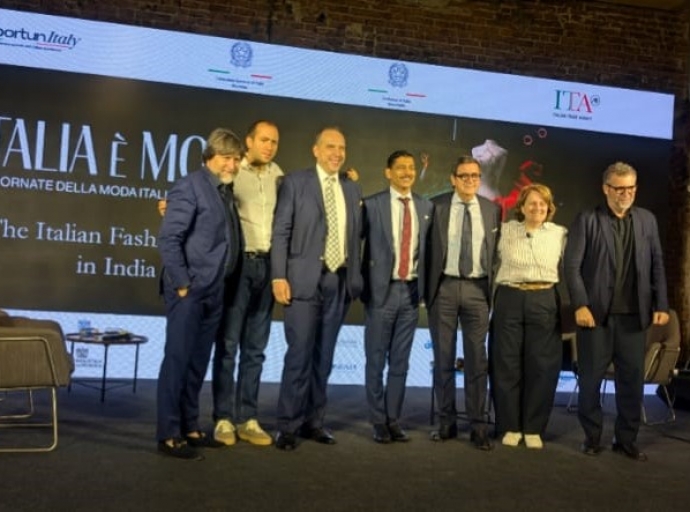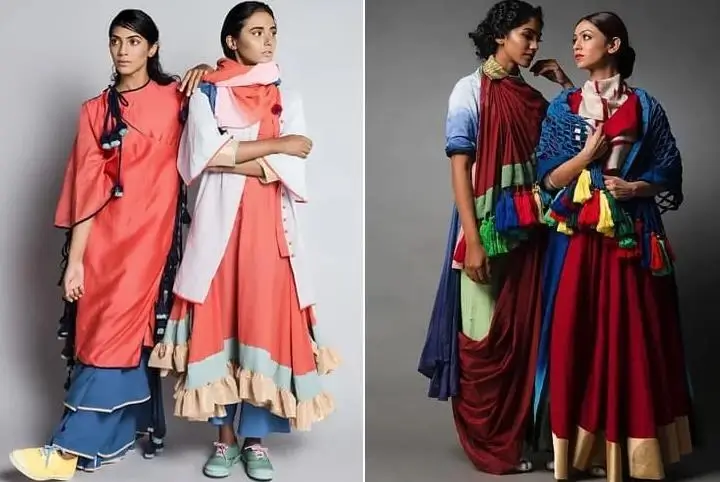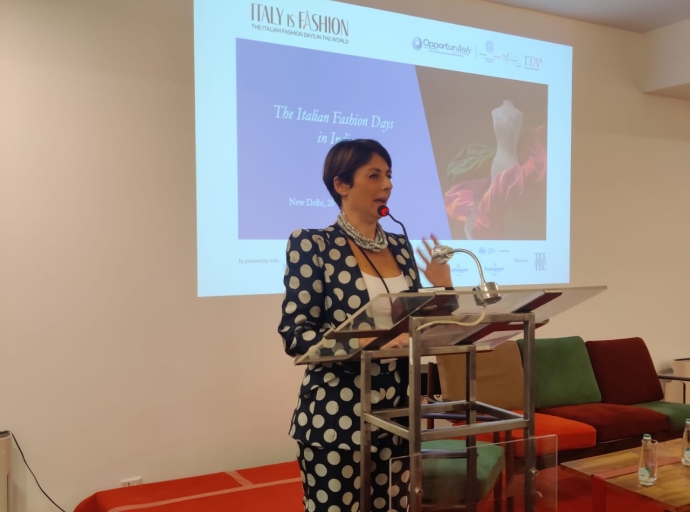Diwali and Dhanteras festive buying push Senco Gold & Diamonds’ sales to an unprecedented high despite highest-ever gold prices and muted Q2 demand.
All Stories
The event 'Italian Fashion Days in India' (Le Giornate della Moda Italiana nel Mondo) officially kicked off on October 28, at the Italian Embassy in New Delhi, marking a significant new step in the strategic partnership between Italy and India.
This three-city, three day initiative, described as the first of its kind in India, is a key component of Italy's "Diplomacy and Growth Strategy", had an eventful day on Oct 29 in Mumbai and the event is set to continue in Ahmedabad on Day 3 on Oct 30, 2025 .
The conversations among Italian fashion leaders on Day 2 in Mumbai revealed a sobering strategic pivot: to protect the globally revered "Made in Italy" label from extinction, Italian brands are embracing a nuanced manufacturing strategy that leans heavily on India’s burgeoning industrial capabilities.
The delicate state of 'Made in Italy'
Speaking at the event, Claudio Marenzi, President & CEO from Herno and Montura, articulated a deep concern over the brand’s future. He warned that the "Made in Italy" label is delicate and faces the same fate as other once-powerful origins, noting that important provenance labels, such as the “Made in England” and “Made in France,” have essentially become "extinct."
The solution, according to Marenzi, is an immediate and deliberate strategy of exclusivity."Made in Italy cannot be used, just for anything. It must be used only for precious products," he stated, referring to materials like cashmere, silk, and the finest wool. This means Italian manufacturing will be strictly reserved for high-luxury items that embody traditional craftsmanship.
India: The strategic manufacturing hub
For products that utilize technical, performing, thermo-woven, or synthetic fabrics—which are key components in modern apparel—Italian brands are now actively looking to foreign partners to ensure efficiency and cost-correct manufacturing.
India, described by attendees as a country with a "great manufacturing culture," is positioned to become a critical partner in this new dual production model.
Read our latest issue
The synergy is driven by India’s capacity to handle modern, high-volume manufacturing that still requires precision, freeing up Italian domestic production to focus solely on irreplaceable luxury craftsmanship.
The economic foundation for this partnership is already robust. Event host, Maria Silvia Sacchi, highlighted that Italy is the world's third-largest fashion exporter, and currently imports garments from India worth over 700 million euros, cementing India's status as one of Italy's key trade partners. This is viewed not as simple outsourcing, but as a reciprocal exchange that strengthens both economies.
Ancient roots, boundless future
This modern economic partnership also rests on centuries of cultural exchange. Attendees noted that the relationship between Italian and Indian fashion is ancient, dating back to the 17th century when Italian royal tailors prized textiles from the subcontinent. Today, India’s rich traditions in embroidery and tailoring continue to be a vibrant source of inspiration for Italian fashion houses.
As India’s dynamic market and manufacturing influence global trends, and Italian creativity finds new expressions through these collaborations, the dialogue during the 'Italian Fashion Days' suggested that this strategic partnership is laying the foundation for a truly "boundless future together."
Fashion designer Aisha Rao made her highly anticipated debut at Hyundai India Couture Week (ICW) 2025 in association with Reliance Brands and an initiative of FDCI. Bollywood actress Sara Ali Khan graced the ramp as the showstopper for Rao's inaugural show.
Rao's brand unveiled its new couture collection, ‘Wild at Heart,’ created in collaboration with Kohler. Inspired by nature's raw and expressive beauty, the collection is shaped by metallics, bold prints, structured silhouettes, and whimsical elements. It delves into the wilderness as both a visual and emotional space, blurring the line between memory and imagination.
Meanwhile, the ongoing ICW 2025 has already showcased collections from ace fashion designers, including Manish Malhotra, Tarun Tahiliani, Falguni Shane Peacock, and Rahul Mishra. Having begun on July 23 with Rahu Mishra’s opening show, the prestigious event witnessed Bollywood actress Tamannaah Bhatia walk the ramp in his exquisite designs.
Renowned designers Shantanu & Nikhil also presented their collection ‘Metropolis,’ as a tribute to sartorial art where western tailoring seamlessly embraces the Indian soul. This star-studded affair was attended by several Bollywood celebrities, including Rajkummar Rao, Arjun Rampal, Jim Sarbh, Shreya Pilgaonkar, Randeep Hooda, and Fatima Sana Shaikh.
ICW 2025 will conclude on July 30 with JJ Valaya's highly anticipated showcase, bringing an end to a week of high fashion and creative brilliance in New Delhi.
In a world saturated with fleeting trends and the relentless churn of fast fashion, a quiet but powerful revolution is brewing. The spotlight is shifting. Consumers aware of the environmental and social costs of rapid production cycles are turning towards something more meaningful, more enduring: slow fashion.
This conscious movement, emphasizing quality, ethical production, and mindful consumption, is steadily gaining momentum in India, mirroring a global shift towards a more sustainable approach to clothing.
Slow fashion moves forward
The global sustainable fashion market was estimated at around $6.35 billion in 2020 and is projected to reach $9.81 billion by 2025, growing at a CAGR of approximately 9.1 per cent during the forecast period. Reports indicate an increase in consumer interest in ethical and sustainable brands.
Terms like "sustainable fashion," "eco-fashion," and "conscious consumerism" are gaining traction, reflecting this growing demand.
India, with its rich heritage of handloom textiles, artisanal crafts, and traditional skills, is uniquely positioned to lead this slow fashion revolution. The growth of slow fashion in India is not just an ethical choice; it's an opportunity to revitalize local economies, preserve traditional crafts, and empower marginalized communities.
Growing importance of slow fashion
The importance of slow fashion's growth, both globally and particularly in India, is multifaceted.
- Environmental sustainability: Fast fashion's demand for rapid production relies heavily on resource-intensive processes, leading to significant water usage, chemical pollution from dyeing and finishing, and massive textile waste ending up in landfills. Slow fashion, with its emphasis on durable, high-quality materials and longer product lifecycles, directly addresses these concerns. By promoting mindful consumption and reducing the demand for constantly new items, it lessens the environmental burden.
- Ethical labor practices: The fast fashion industry has often been criticized for poor working conditions, low wages, and exploitation of garment workers, often in developing countries. Slow fashion brands typically prioritize fair wages, safe working environments, and transparent supply chains, ensuring the well-being of the people who make our clothes. In India, this can translate to better livelihoods for artisans and weavers.
- Preservation of craft and heritage: India boasts of diverse traditional textile techniques and artisanal skills passed down through generations. The rise of slow fashion provides a platform for these crafts to thrive, preventing their extinction in the face of mass-produced alternatives. Supporting these artisans not only preserves cultural heritage but also creates economic opportunities in rural communities.
- Empowering local economies: By choosing locally made, handcrafted garments, consumers directly support local businesses and artisans, contributing to the economic growth and stability of their communities. This contrasts with fast fashion, where profits often flow to large corporations, with limited local economic benefit.
- Promoting mindful consumption: Slow fashion encourages consumers to think critically about their purchases, considering the origin, materials, and longevity of their clothes. This shift away from impulsive buying fosters a more conscious and responsible approach to consumption, ultimately leading to less waste and a greater appreciation for the value of clothing.
Building brands in slow fashion
Small clothing brands are at the forefront of the slow fashion movement. Here are a few examples of Indian brands and startups that embody the ethos of slow fashion:
- No Nasties: This Goa-based brand focuses on organic cotton clothing for adults and children, emphasizing fair trade practices and transparent supply chains. Their commitment to ethical sourcing and production has garnered them a loyal customer base. Their business model revolves around direct-to-consumer sales through their website, allowing them to maintain control over their values and customer relationships.
- Doodlage: Doodlage is a Delhi-based brand that upcycles factory waste and surplus fabrics to create unique and stylish clothing. Their innovative approach to minimizing textile waste and their focus on contemporary designs have made them a notable name in sustainable fashion in India. They retail through their own stores and online platforms, showcasing that sustainability can be synonymous with high fashion.
- Mishé: This brand works with artisans across India, celebrating traditional crafts like hand-block printing and natural dyeing. They focus on creating timeless pieces with a contemporary aesthetic, highlighting the skill and artistry of their craftspeople. Their business model emphasizes fair wages and ethical sourcing, positioning them as a brand that values both people and the planet.
- B Label: Part of the Bombay Hemp Company (BOHECO), B Label utilizes hemp textiles to create sustainable and durable clothing. Hemp is known for its low environmental impact, requiring less water and pesticides than conventional cotton. B Label's focus on this eco-friendly material and their commitment to ethical production showcase the potential of innovative materials in slow fashion.
The rise of social media and e-commerce has been a game-changer for small, slow fashion brands. It allows them to bypass traditional retail barriers and connect directly with consumers who resonate with their values. This direct engagement fosters trust and loyalty, crucial elements for building a sustainable brand.
The inaugural 'Italian Fashion Days in India' (Le Giornate della Moda Italiana nel Mondo) officially kicked off yesterday, October 28, at the Italian Embassy in New Delhi, marking a significant new step in the strategic partnership between Italy and India.
This three-city initiative, described as the first of its kind in India, is a key component of Italy's "Diplomacy and Growth Strategy" and is set to continue in Mumbai and Ahmedabad on October 29 and 30, respectively.
KNOW MORE
Fashion as a driver for business and cultural exchange
The launch event was highlighted by Italian officials as being much more than a showcase for luxury goods. Aurora Russi, Minister Counsellor at the Embassy of Italy, emphasized the multi-faceted goal of the initiative, noting that the Embassy was "delighted to take some of our best examples of fashion and fashion industry to New Delhi, Mumbai and Ahmedabad." She stated that while the event celebrates the "strength and excellence of Made in Italy," it also aims to underline that "fashion is a driver for business and cultural exchanges between our two countries." Russi acknowledged that fashion is considered "luxury on some aspects," but maintained that it is also a "generator of richness at all levels."
Join our group
High-Profile delegation and creative programming
The event, launched globally by Italy’s Deputy Prime Minister and Minister for Foreign Affairs, Antonio Tajani, is proposing a direct interaction with India's dynamic fashion ecosystem. The opening day in New Delhi featured a prominent Italian delegation, including: Matteo Marzotto, President of Minerva Hub; Antonio De Matteis, CEO of Kiton and President of Pitti Immagine; Giacomo Tonelli of Minerva Hub; Claudio Marenzi, President of Herno and Montura; and Alberto Racca, CEO of Gruppo Mirolo and Trussardi. Indian designers David Abraham and Vinu Singh were also welcomed to interact with the Italian contingent. Speaking on the depth of the showcase, Ms. Russi explained that covering Italian fashion in India "wouldn't be easy just with one or two words or one or two names." Following the talks, the delegation opened the exhibition, ‘Italia è Moda’ (Italian Fashion), curated by Clara Tosca Manfini.
Fashion Guru
Optimism amidst global trade challenges
The timing of the Fashion Days underscores Italy's focus on the Indian market during a period of complex global trade dynamics. Russi addressed the ongoing challenges, including the impact of Trump-era tariffs, and viewed them as an "opportunity" for diversification. "We need to see the tariff happenings, what happened around tariffs as an opportunity," she said, suggesting that it encourages "European firms, European institutions to work even more with India." Furthermore, she expressed great anticipation for the forthcoming EU-India Free Trade Agreement (FTA), stating, "We are all attaching huge importance to this and we are looking forward to a development that will be beneficial to both the European system and both the Indian market." The FTA is expected to be finalized potentially "less than within six months."
Join our community
Deepening a strategic partnership
The fashion initiative is firmly situated within a wider context of strengthening bilateral ties, which have been elevated to a "strategic partnership" by the two countries' Prime Ministers. Economic collaboration has been robust throughout 2025, with two major business forums already having taken place.
The first was in New Delhi in April, attended by Deputy Prime Minister Tajani and around 400 Italian businesses.
Read our latest issue
The second forum was held in Brescia, Northern Italy, with Minister Goyal and Minister Tajani participating. Russi confirmed that a third business forum will be brought to India in the "next few weeks," stating, "We really believe that Italian and Indian businesses need to work together more." The two nations are focusing on numerous economic sectors beyond fashion, including machinery, agri-tech, and technical textiles.
In closing the event, Russi expressed the Embassy's delight, hoping this is "just the first of many Italian Days dedicated to made-in-Italian fashion."
The question, ‘Do we really need a T-shirt or underwear in 15 minutes?’ once posed with a hint of skepticism, is now at the heart of a growing retail transformation in India. As quick commerce (Q-commerce) platforms rapidly expand their horizons beyond daily groceries, fashion, surprisingly, is emerging as a significant growth frontier.
From essential innerwear and basic T-shirts to trendy loungewear, apparel has found an potent new sales channel – not through traditional retail fanfare, but via the promise of 15-minute delivery on popular apps.
This isn't merely a supply chain adjustment; it's a reflection of a profound psychological shift in consumer behaviour where immediacy has become a non-negotiable expectation. The Indian online apparel market, a substantial sector valued at approximately Rs 1.72 lakh crore in 2024 as per Statista, is witnessing this rapid evolution firsthand.
"Apparel was never considered a quick-buy category. But today, impulse is the driving force of millennial and Gen-Z shopping behaviour," notes an Apparel Strategy Lead at a prominent q-commerce firm. This sentiment is backed by statistics, with some Qcommerce platforms reporting 7X growth in apparel orders in the last 18 months alone.
Table 1: Q-commerce apparel trends in India (2024-25)
|
Metric |
Value |
YoY growth |
|
Apparel Share of Q-Commerce GMV |
6.80% |
↑ 180% |
|
Top Apparel Items Ordered |
Innerwear, T-shirts, Athleisure, Loungewear, Everyday Basics |
--- |
|
Average Order Value (AOV) for Apparel |
₹684 |
↑ 14% |
|
Cities Leading Q-Commerce Fashion |
Bengaluru, Mumbai, Delhi NCR |
--- |
|
Average Conversion Time (Search to Order) |
<3 minutes |
↓ 35% (faster) |
(Source: Compiled from industry reports and internal analytics from major q-commerce players, 2025).
The anatomy of the 15-minute apparel order
What's leading to this unprecedented demand for instant fashion? Experts point to a combination of ‘Speed + Need + Simplicity’. For example last-minute travel revealing a missing pair of socks or a crucial T-shirt. Then there is the sudden realization at dawn about the lack of clean gym shorts for a workout.
Or a social spontaneity like impromptu weekend plans demanding a quick wardrobe refresh. And then there is the aspect of comfort economy. With more people working from home or prioritizing comfort, the impulse to buy cozy daily wear is high.
"We’ve seen customers ordering innerwear at 10 PM before a red-eye flight or a new tee minutes before a date,” shares a Category Head for Fashion at a leading q-commerce platform. “This isn’t a gimmick—it’s filling a real, unmet convenience gap.”
Apparel brands riding the Q-commerce wave
The synergy between apparel brands and q-commerce platforms is already yielding impressive results. For example, A major Q-commerce player partnered a popular men’s innerwear brand in 2023 to explore demand for essentials via ultra-fast delivery. The outcomes within six months were telling: sales grew 240 per cent in two major metros, with 70 per cent orders being placed post-8 PM. The demand was so high it compelled the platform to triple its warehouse allocation for the brand to prevent stock-outs. No wonder the sale director at the innerwear brand saw Q-commerce as perfect for their. As per him, underwear is often an afterthought—until it’s urgently needed. That’s when they win.
Reshaping the apparel supply chain
Delivering apparel in minutes requires a fundamental re-engineering of the traditional apparel supply chain, which is typically geared for longer lead times and seasonal cycles.
- Hyperlocal warehousing (dark stores): A dense network of urban micro-fulfillment centers (dark stores) stocking a curated, high-demand apparel inventory is essential.
- Intelligent inventory management: AI-driven analytics are vital for forecasting hyperlocal demand for diverse SKUs (sizes, colors) and optimizing stock. Solutions include zoning inventory based on pin-code demand patterns, partnering with brands for pre-packed "bestseller bundles," and curating a focused catalog to ensure high SKU velocity.
- Agile logistics: A robust, algorithm-optimized delivery fleet forms the backbone of the rapid delivery promise.
However, this speed and agility come at a price, differing from traditional e-commerce
Table: Comparative supply chain costs (per apparel order)
|
Cost Component |
Traditional E-Commerce |
Q-Commerce (Urban Zones) |
|
Picking & Packing |
₹12 |
₹18 |
|
Last-Mile Fulfillment |
₹18 |
₹35–₹50 |
|
Return Handling (avg.) |
₹25 |
₹10–₹15 (often lower due to category/price point) |
Impact on broader e-commerce and offline retail
The rise of q-commerce is undeniably sending ripples across the entire retail ecosystem, forcing existing players to adapt or risk obsolescence. This new speed paradigm is creating distinct operational models and consumer expectations compared to established channels.
Table: Q-commerce vs. traditional e-commerce & offline retail for apparel
|
Feature |
Q-commerce (apparel) |
Traditional e-commerce (apparel) |
Offline retail (apparel) |
|
Delivery Time |
10-60 minutes |
1-5 days (or more) |
Instant (in-store purchase) |
|
Product Range |
Limited, curated essentials, basics, high-demand items |
Extensive, wide variety of brands, styles, collections |
Variable, depends on store size & specialization |
|
Primary Driver |
Speed, immediate need, impulse |
Selection, price, planned purchases, brand discovery |
Touch & feel, trial, immediate possession |
|
Key Challenge |
Profitability, inventory for fashion, returns logistics |
Competition from q-commerce, delivery speed expectations |
Competition from online, footfall decline |
|
Consumer Focus |
Urgent, need-based, convenience-seeking |
Broader consideration set, brand loyalists |
Experiential shoppers, immediate need, local |
|
Supply Chain |
Hyperlocal dark stores, real-time inventory |
Centralized/regional warehouses, planned logistics |
Physical stores, traditional distribution |
Standard e-commerce, with its 1-3 day delivery window for apparel, is facing new pressures. Q-commerce is reportedly taking market share from both traditional e-commerce giants and local stores. Recognizing this shift, even established large e-commerce platforms are now offering "Next Day Prime" apparel, but the 15-minute delivery benchmark set by q-commerce establishes a significantly higher bar for immediacy. In response, some apparel-specific e-commerce platforms are reportedly investing in their own dark stores to pilot hyperlocal models in major cities, attempting to bridge the gap.
Offline retail, particularly small, local apparel stores and boutiques, are also feeling the impact. "Our walk-ins for basics have dropped 20 per cent YoY," revealed the owner of a multi-brand boutique in Delhi. "We’re launching a 60-minute delivery promise via a hyperlocal delivery service to compete." This indicates a move by some offline players to adopt quicker fulfillment methods to retain their customer base.
Experts are increasingly convinced that Q-commerce for certain apparel segments is here to stay. Predictions suggest that by 2027, up to 22 per cent of urban apparel orders in India could be fulfilled via q-commerce, particularly for categories like: innerwear, athleisure, loungewear, basic apparel and seasonal items or those driven by pop culture trends
However, luxury fashion, high-value occasion wear, and categories requiring extensive browse or trial are deemed unlikely to transition to the 15-minute model. The model works best where urgency meets low consideration. That’s a sweet spot where Q-commerce will dominate, say retail analysts.
Convenience is king
Fast fashion is acquiring a new definition – it's no longer just about rapidly changing trends, but literally about the speed of acquisition. India's Q-commerce sector is adeptly carving out a new niche, not necessarily by competing with high-fashion labels or elaborate retail experiences, but by addressing everyday wardrobe gaps and urgent needs.
What might have started as an almost whimsical query, "Who needs a T-shirt in 15 minutes?" has rapidly evolved into a practical urban fashion utility. As a young working professional from Bengaluruput says he didn’t plan to shop or go out. So he hit order—and his joggers arrived before the food did.
This sentiment underscores a fundamental truth: Q-commerce in apparel is less a gimmick and more a direct response to an evolving consumer mindset where convenience reigns supreme.
Global multi-sports apparel and lifestyle brand Decathlon plans to boost its online presence in India and reach shoppers in smaller cities and towns. For this initiative, the brand has teamed up with Tata Cliq Fashion to make communities healthier and happier, says Shankar Chatterjee, CEO, Decathlon India.
Dedicated to providing a comprehensive and top-notch omni-channel experience through online collaborations, Decathlon offers high-quality products to sports enthusiasts. Using Tata Cliq Fashion’s customer base, the brand uses technology to offer a more convenient and inclusive sports retail experience.
Decathlon has launched over 5,000 sports products on Tata Cliq Fashion's platform, joining more than 4,000 Indian and international brands on the online store. The brand offers products across 60 sports categories, now available for delivery to over 24,000 Indian postal codes through Tata Cliq Fashion.
Tata Cliq is committed to offering a varied and carefully chosen selection that meets the changing tastes of its customers, says Gopal Asthana, CEO, Tata Cliq. One of its best-performing areas, the sports and fitness category on the platform contributes significantly to its overall revenue. The platform’s expansion with Decathlon's outstanding quality and extensive product range perfectly aligns with its goal to provide a complete sporting solution for every consumer. Together, the two companies aim to transform how the nation shops for sports and fitness essentials, taking a significant step toward building a healthier and fitter India, he adds.
India's fashion e-commerce market is projected to reach over $98 billion by 2032. Yet, beneath this headline-grabbing potential lies a difficult truth: not all growth is created equal.
While a select few D2C (Direct-to-Consumer) fashion start-ups are building multicrore enterprises, many others are caught in a cycle of high cash burn and eventual collapse.
The key differentiator, as a hard look at the data reveals, is a fundamental shift in strategy: margins beat scale every time.
This trend mirrors the broader Indian start-up ecosystem where a focus on unit economics and value creation is finally trumping the 'growth at all costs' narrative.
For fashion and fashion tech, this means success is defined not by how much funding a brand raises or how many customers it acquires through deep discounts, but by its ability to build a profitable, resilient business from day one.
The margin-first mindset
Successful Indian fashion start-ups don't just sell clothes; they sell a story, a purpose, and a tightly controlled experience that boosts their profit margins.
They've learned to play the ‘margin game’ by focusing on a few key pillars.
The value-add premium: Instead of competing solely on price, successful brands create a premium by adding value. This can be through superior design, sustainable sourcing, or a compelling brand narrative.
For example, Snitch, a men's fast-fashion brand, found success by offering trendy, high-quality styles at affordable prices. They built a strong D2C model and leveraged social media to engage a community of followers.
By owning their brand and customer relationship, they've achieved traction, reaching a valuation of Rs 900 crore. Their focus on speed and style allows them to command better margins than traditional retailers.
This D2C model is crucial because it allows brands to cut out middlemen, from wholesalers to distributors, thereby increasing their gross margins.
A typical D2C fashion brand can aim for 50-70 per cent gross margins, a stark contrast to the thin single-digit margins seen in traditional wholesale.
The power of brand story and community: In a crowded market, a strong brand identity is a defensible moat. This is where start-ups like The Souled Store have thrived.
They didn't invent clothing; they packaged pop culture, fandom, and a sense of community into wearable merchandise. This brand loyalty encourages repeat purchases and reduces the need for expensive customer acquisition, a major win for profitability.
The average customer lifetime value (LTV) for a D2C fashion brand is highly dependent on its repeat purchase rate. Brands with a strong community can achieve a higher LTV, justifying their initial customer acquisition costs (CAC).
A healthy LTV/CAC ratio of 3:1 or higher is often the benchmark for investors.
Technology as a margin enabler: Fashion tech isn't just about building an app; it's about using technology to optimize operations and boost profit. Successful start-ups use tech to reduce return rates.
Tools like AI-powered sizing recommendations and virtual try-ons address the biggest margin killer in online fashion: returns. Industry feedback suggests return rates can be as high as 35-50 per cent for some online apparel categories. Reducing this directly impacts the bottom line.
Tech also helps in optimize supply chains. Data analytics helps in demand forecasting, preventing overstocking and markdown losses. And personalized recommendations increase average order value (AOV) and customer loyalty.
Why they fail is the scale trap
For every success story, there are countless failures, often rooted in a few common missteps that prioritize scale over sustainability. The most common mistake is around high cash burn and unsustainable unit economics.
They chase growth at any cost. Start-ups often spend excessively on marketing, influencer campaigns, and deep discounts to acquire a large customer base. This approach is unsustainable, especially when the unit economics don't add up.
A start-up may achieve a high Gross Merchandise Value (GMV), but if its Cost of Goods Sold (COGS) and Customer Acquisition Cost (CAC) are too high, it will bleed cash with every sale. This leads to a vicious cycle of needing more funding to cover operational losses.
Over-reliance on funding is another cause. Many start-ups in the scale trap play the funding game, not the margin game. They operate with the assumption that a new round of funding will always be there to bail them out.
In a funding winter, this strategy becomes a house of cards. The pattern is clear: aggressive growth, followed by a need for more capital, and finally, a painful restructuring or shutdown when the funds dry up.
Operational inefficiencies also lead to failures. The fact is poor operational discipline can kill a brand faster than a lack of funding. Inconsistent sizing, slow order fulfilment, and a chaotic return process lead to customer dissatisfaction and high churn. This is the ‘scale trap’ at its worst, a flood of orders with no backend infrastructure to handle them, resulting in a reputation for poor quality.
Table: A tale of two strategies
|
Feature |
Margin-first success |
Scale-first failure |
|
Business Model |
Direct-to-Consumer (D2C) with a strong brand story and value-add. |
Marketplace-heavy, relies on deep discounts for sales volume. |
|
Metrics |
Focus on Gross Margin, LTV/CAC ratio, and customer retention. |
Obsessed with GMV, MAUs (Monthly Active Users), and funding rounds. |
|
Strategy |
Build a loyal community, use tech to optimize operations, and grow steadily. |
Acquire customers rapidly through discounts, often ignoring profits. |
|
Outcome |
Sustainable, profitable growth with higher valuations in the long run. |
High cash burn, struggles to raise follow-on funding, and eventual restructuring or shutdown. |
Read our latest issue
Building value, not just valuation
The Indian fashion start-up ecosystem is maturing. The focus is shifting from a 'unicorn race' to ‘profit marathon.' The next wave of successful start-ups will be those that build businesses that generate cash, not just headlines.
They will be the ones who understand that in the end, a business is only as valuable as its ability to be profitable. This means meticulously managing margins, building a brand people love, and using technology as a lever for efficiency not just for flash.
Indian occasion and ethnic wear brand Kalki Fashion plans to support its retail growth with Rs 225 crore (approximately $27 million ) investment secured from Lighthouse Funds.
According to Saurabh Gupta, Founder and CEO, Kalki Fashion, this partnership allows the company to not only expand its retail presence in both Indian and international markets but also improve supply chain, and continue investing in new product development and customer experience to better serve its customers, states Saurabh Gupta, Founder and CEO, Kalki Fashion.
Actively increasing its physical store presence in India and abroad, the high-end apparel brand reports strong financial performance per store along with consistent profit growth.
Kalki Fashion operates several large flagship stores in major Indian cities and also provides a personalized shopping experience through its direct-to-consumer (D2C) online platform.
Anshul Jain, Managing Director, Lighthouse Funds, explains, having established a strong brand in the premium occasion wear market, emphasizing quality and craftsmanship, Kalki is well-positioned to become the preferred brand for consumers seeking elegance and exclusivity.
Founded in 2007 by Saurabh, Shishir, and Nishit Gupta, Kalki offers premium bridal, festive, and occasion wear for both men and women. The brand also has a significant customer base in the US, the UK, Canada, and Australia.
Lighthouse Funds has previously invested in apparel brands like Fabindia and occasional accessories brands like Kushal's. Their other investments include Wow! Momo, Kama Ayurveda, Duroflex, and Nykaa.
At a recent presentation in New York, Indian fashion designer Tarun Tahiliani offered 100 guests an up-close look at his designs.
This exclusive event featured live models, a slideshow about the history of Indian fashion, and insights straight from the designer himself. It was attended by several celebrity guests including Shalini Misra, an internationally known interior architect and designer, were Bibhu Mohapatra, Navina Haidar, Indira Nooyi, Shalini Misra, Ashok Mathai, Preetha Nooyi, Susan Gutfreund, Libby Rothschild, Malini Murjani, Maya Rana Tufoe, and Fern Mallis.
At this event, Tahiliani emphasized the artistry of the Indian drape – where using nine yards of fabric is common for certain garments. Visitors to this event were attracted by intricate embroidery and luxuriousness of the displayed clothing. Tahiliani also mentioned his book, ‘Tarun Tahiliani: Journey to India Modern,’ which was launched in 2023.
A graduate from the Wharton School of Business, Tahiliani opened his first multi-brand store in 1987. Since then, he's expanded into bridal wear, menswear, accessories, and couture. After graduating from the Fashion Institute of Technology, Tahiliani staged his first runway show in 1994 at the Dorchester Hotel in London. A year later, he launched his signature design studio with a team of 10. Post-pandemic, Tahiliani introduced the brand – OTT under the Tarun Tahiliani umbrella to offer a collection of India-inspired modern separates.
His designs include a woven textile lehenga with his signature ‘TT’ embroidered hip yoke, paired with a pearl and sequin-embroidered blouse. The design features a tulle drape with matching borders and tassels. He has repeatedly pointed out how his heritage and Indian craftsmanship have influenced his approach, but he interprets elegance in a more contemporary way..
The designer drew inspiration from Chikankari embroidery, Benares brocades, Greek-inspired drapes from the Gupta period, and Pichwai art that originated 400 years ago in Nathdwara, Rajasthan. Guests were also offered a peek at the embroidered walls created under his supervision alongwith embroidered canopies used for lavish weddings.




















